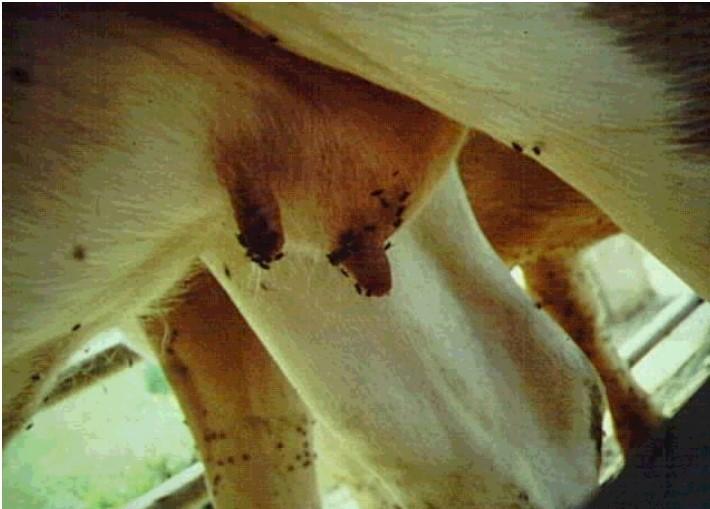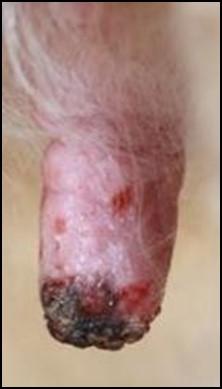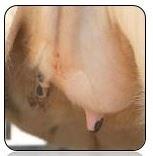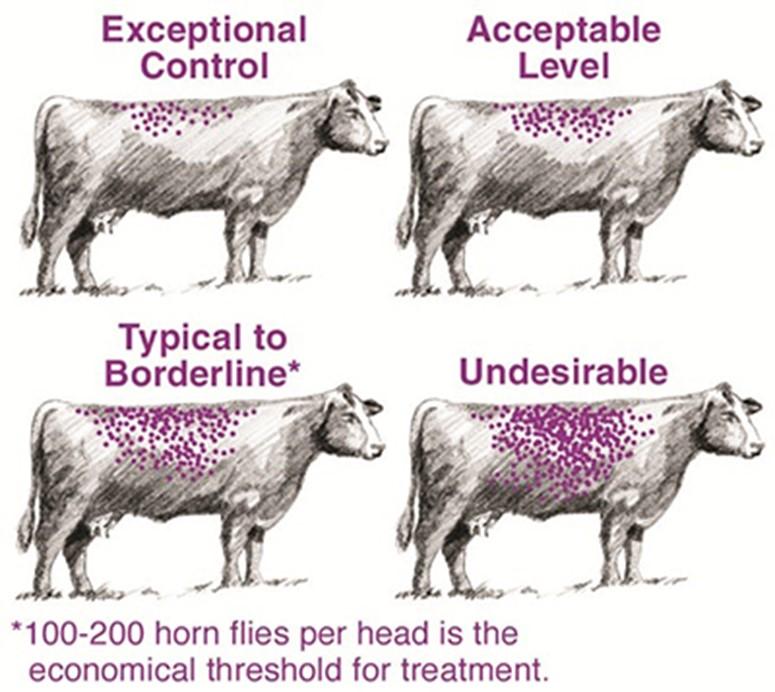Preventing Summer Mastitis In Heifers Begins with Horn Fly Control
Preventing Summer Mastitis In Heifers Begins with Horn Fly Control

“Summer Mastitis” is an infection in the mammary gland of a heifer caused by horn flies biting the teat ends and introducing bacteria during udder development. Horn flies suck blood from the teat skin and, at the same time, inject the mastitis-causing bacteria (usually Staphylococcus aureus or Trueperella pyogenes) into the wound (Picture 1). The bacteria grow and multiply, causing an abscess to form followed by a scab on the teat end (Picture 2). Once the scabs are present, the bacteria can easily enter the teat canal and begin destroying the milk-producing tissue that leads to extensive scar tissue and, ultimately, little to no milk in the quarter at freshening.
A heifer with a case of mastitis will typically have one or more affected quarters that are swollen (Picture 3) and when checked, produce an abnormal secretion. Some exhibit signs of illness such as fever and anorexia (off feed) while others show no outward signs.
Once the infection is over, the quarter is usually damaged and produces much less milk (a light quarter) or dries up completely (a blind or dry quarter) for the rest of her life. If mastitis is suspected in a heifer, she should be treated in all 4 quarters with an intramammary antibiotic followed by administration of teat sealant to prevent establishment of new infections. Dry cow therapy can be used if the heifer is at least 30 days from calving. Lactating cow products should be used if expected calving date is between one month and up to two weeks prior to calving. Both dry and lactating cow therapy in prepartum heifers are extra-label uses of an antibiotic and should be used only at the direction of a licensed veterinarian. Cure rates may reach 90% or better if heifers are treated correctly during pregnancy. Milk from any previously treated fresh heifer should be tested for antibiotic residue before adding to the bulk tank.

Percentages of heifers with mastitis in herds with and without fly control. Graphic courtesy of Dr. Steve Nickerson, University of Georgia



| Picture 1 (Left): Horn flies biting the teats of a heifer. Picture 2 (Right): Teat scabs due to horn flies are the source of bacteria causing summer mastitis. Picture 3 (below right): Mastitis quarter in young heifer. Photos courtesy of Steve Nickerson, University of Georgia. |
Controlling horn flies is the most important factor to prevent summer mastitis and its lifelong damage to milk production. Horn fly feeding causes irritation and blood loss which also leads to less time spent grazing, resulting in weight loss. In Kentucky, cattle fly season begins in late spring and continues until early fall. Horn flies are blood feeders and stay on cattle almost continuously, leaving only when disturbed or to lay their eggs in fresh manure, their only breeding site. These flies sit primarily on the shoulders, backs, and sides of cattle and each one takes 20 to 30 small blood meals a day. On summer afternoons they can also be found on the belly region of cattle. Weight losses in cattle occur when horn fly numbers exceed 100 per side or 200 per animal (see Figure 2).
Insecticides can be applied to cattle by ear tags, dust bags, oilers, pour-ons, sprays, or in mineral or feed to treat manure. Each method has advantages and disadvantages. Insecticide-impregnated ear tags can provide excellent long term horn fly control and can suppress face fly numbers. In general, two ear tags per head give better face fly protection than one. Apply tags in late May or early June when the horn fly population reaches 100 per side. Remove tags at the end of the fly season (September/October). Protective gloves should be worn when applying or removing tags.
Pour-ons or animal sprays give 2 to 3 weeks of protection and must be repeated as needed. Forced-use dust bags can keep the face treated to protect against face flies and also work well against horn flies. Follow directions for the application amount and timing and meat and/or milk withdrawal time, and discard empty containers properly.
Feed additives target fly maggots breeding in fresh animal manure. Results can be very variable. All animals must eat a minimal dose of a feed additive regularly. In addition, supplementary control measures must be taken to deal with adult flies moving in from nearby herds. Methoprene, an insect growth regulator (IGR), is available in Altosid® Block, Tub, and Liquid products for horn fly control. The organophosphate insecticide Rabon® (stirofos) is available as a 7.76% Premix for horn fly and face fly control. Clarifly® (diflubenzuron) is available in several premix forms for horn fly and face fly control. It is essential to start offering these feed-through products 30 days before fly season begins and continue until 30 days after fly season is over.

Figure 2: *100-200 horn flies per head is the economic injury level and signals the need for control measures. Picture courtesy of Dr. Lee Townsend, UK
Horn flies can become resistant to some groups of insecticide if used for several consecutive years. The main insecticide groups are synthetic pyrethroids (P), organophosphates (OP), and abamectins. Alternate the insecticide type (P or OP) and/or methods of control to eliminate insecticide-resistant populations of flies. Use of alternative methods of fly control late in the season is encouraged to reduce the percentage of flies overwintering with resistance.
For complete information regarding insect control for dairy cattle, download the UK Factsheet ENT-12 “Insect Control for Dairy Cattle-2019” prepared by Drs. Lee Townsend and Ric Bessin, UK Extension Entomologists, at https://entomology.ca.uky.edu/files/recs_0/ent12-dairy.pdf
Authors: Dr. Michelle Arnold, Ruminant Extension Veterinarian, and special thanks to Dr. Lee Townsend, UK Extension Entomologist (retired) for his contributions
